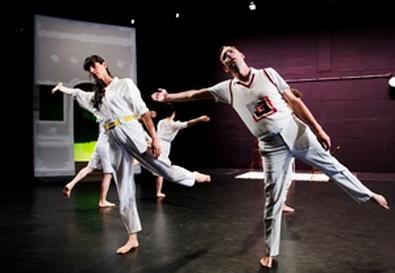
Photo Source: Ian Douglas
Back in the day, established choreographers on New York’s downtown dance scene would present a full evening of work, typically four or five distinct pieces that, while they may have been of a particular aesthetic, explored a variety of tones, concepts, or choreographic characteristics. But today the sign of stature among choreographers seems to be a performance that consists solely of an “evening-length” work. And I use the quotation marks intentionally, as the term in the contemporary dance world refers not to a two-hour narrative dance (as it might at the ballet) but to what is frequently a work of an hour or less in duration. (Ticket prices for such performances, however, remain equivalent to that of a full evening production.)
Not only are audiences getting less quantitatively, but we are expected to assume a central role in creating meaning out of what is presented onstage. Rather than an expertly crafted piece of theatricalized, stylized, or even pedestrian physical movement that teaches us something new or different about ourselves and our world, we are presented with postmodern mishmashes of images, sounds, and whatnot, out of which we must assemble something of significance. And this assembling is heavy-lifting. It’s different from the personal interpretation that viewers of art have always engaged in with natural ease.
In the contemporary-dance value system, clarity of expression has been replaced by the presentation of an array of stimuli that are simply of some interest to the choreographer. Performances involve us watching the artist “play with his toys” while we draw from the experience whatever we choose.
In “Restless Eye,” a new, nerdy 60-minute work by David Neumann, we see the five members of his company, only two of whom can technically dance, perform intermittent sequences of purposely disjointed movement phrases. We try to watch the videos projected on the back wall of set designer Gordon Landenberger’s gazebo-like structure (possibly a reference to the piece’s Chekhovian stage directions and tableaux), but the door frame and lower wall obstruct most of our view. The performers sometimes wear NeuroSky MindWave headsets that allow them to control changes in Christine Shallenberg’s lighting via their brainwaves. (Don’t ask; I have no idea.) At other times they speak into microphones, telling descriptive anecdotes about places. There are also audio recordings of lunar astronauts from the 1960s.
Presented by and at New York Live Arts, 219 W. 19th St., NYC. March 24–April 1. Tues.–Sat., 7:30 p.m.; Sun., 5 p.m. (212) 924-0077 or www.newyorklivearts.org.